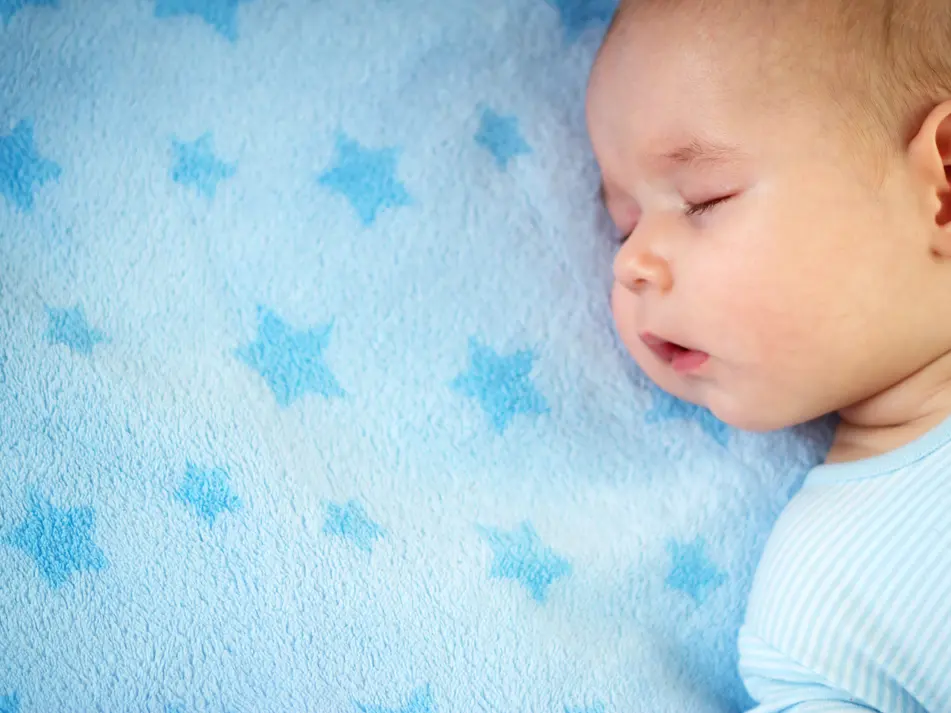Baby Sleep 3 to 6 Months

On this page
- How much sleep does my baby need?
- An example of a 3 to 4 month old sleep routine
- An example of a 5 to 6 month old sleep routine
- 3 to 6 month old bedtime routine
- How do I settle my baby for sleep?
- Soothing in arms
- Hands on settling: 3 to 6 months
- What are sleep cycles?
- Baby Safety (SIDS Guidlines)
- Baby sleep FAQs
How much sleep does my 3 to 6 month old baby need?
Babies sleep patterns vary however most babies at this age sleep 14 or 15 hours spread across both day and night. As your baby grows, they will sleep for longer periods throughout the night with 2-3 shorter sleeps during the day. If your baby is happy during wake periods during the day, they have had enough sleep.
What are my baby's tired signs
Babies show ‘tired signs’ when they are getting tired and need sleep. These signs include grimacing, yawning, grizzling, frowning, sucking, staring, snuggling in, jerky movements, becoming over active, clenching fists, rubbing eyes, fussiness or crying.
Responding early to these tired signs prevents your baby becoming distressed and makes it easier to them to sleep.
An example of a 3 to 4 month old sleep routine
Night time sleep: By 3 months, the period of sustained night time sleep will have lengthened up to 5 - 6 hours a night, twice a night. They will still wake briefly 1 - 3 times during these longer stretches and some babies may be able to self-settle back to sleep.
Daytime naps: 3 daytime naps (3 - 4 hours in total)
3 - 4 month old wake window: 2 hours or so.
Feeding: Every 3 - 4 hours.
An example of a 5 to 6 month old sleep routine
Night time sleep: By around 6 months, the period of sustained night time sleep has lengthened to 6 hours a night, twice a night. They will still wake briefly 1 - 3 times during these longer stretches and some babies may be able to self-settle back to sleep.
Daytime naps: 2 to 3 daytime naps (3 - 4 hours in total)
5 - 6 month old wake window: 2 - 3 hours.
Feeding: Every 3 - 4 hours.
3 to 6 month old bedtime routine
-
1
Give your baby a bath - this is soothing and can help relax your baby before bed.
-
2
You could try giving your baby a gentle massage before you get them dressed.
-
3
Put your baby in their nappy and pyjamas.
-
4
Using a soft, low and quiet voice, read stories or rhymes, sing songs and/or lullabies.
-
5
Give them plenty of warm cuddles.
-
6
Place your baby on their back in their own bed.
-
7
Turn out the lights and leave the room.
How do I settle my baby for sleep?
For babies aged three to six months, Tresillian recommends either soothing in arms or hands-on settling to calm your baby.
Learning how to go to sleep is a skill babies usually develop during the first year of life with help from their parents. Like most skills, it takes time and varies for each baby.
Soothing in arms
-
1
Hold your baby in your arms until they fall asleep before putting them in the cot.
-
2
Use gentle rhythmic patting, rocking, stroking, talking or softly singing. Being repetitive and consistent signals relaxation and sleep.
Hands on settling: 3 to 6 months
-
1
Start by wrapping your baby in a light cotton fabric.
-
2
Talk quietly and cuddle your baby until they're calm.
-
3
Put your baby on their back in the cot awake but calm/drowsy.
-
4
Comfort your baby with gentle ‘ssshhh’ sounds, gentle rhythmic patting, rocking, or stroking until your baby is calm or asleep.
-
5
If your baby becomes distressed, pick them up for a cuddle until they're calm or they fall asleep before putting them back in the cot.
-
6
Provide comfort to your baby and stay until they're asleep.
What are sleep cycles?
- Your baby’s sleep-wake cycle is the time spent going through both deep (quiet) and light (active) stages of sleep.
- A baby sleep cycle is around 30 to 50 minutes and babies rouse, briefly wake and re-settle.
- They have these sleep cycles throughout the night and may not be able to self-settle.
- In the early months, babies need to be physically close to their parents and some need help going to sleep or re-settling.
Baby Safety (SIDS Guidelines)
Baby safe sleeping is very important.
- Sleep baby on the back from birth, not on the tummy or side.
- Sleep baby with head and face uncovered.
Baby Sleep FAQ's
In the early weeks, this is normal behaviour. Babies need to be physically close to their parents and some need help going to sleep or re-settling. Comforting with cuddles is the best way to settle your baby when they're crying.
Wrapping can also help – use a light material such as cotton making sure that the arms are above waist level and there is room to move the legs.
Also check how you are feeding your baby and whether or not there is a link between how the baby is feeding (i.e. fast or gulping or snacking) and their unsettled behaviour.
At 4-5 months, your baby’s sleep cycle is around 30-50 minutes and then babies can rouse. It’s very common for babies to wake up after 30-40 minutes sleep at this age.
There are several ways of re-settling. Hands-on settling is one option where you comfort your baby with gentle ‘ssshh’ sounds, gentle rhythmic patting, rocking or stroking until baby is calm or asleep.
If your baby becomes or stays distressed pick them up for a cuddle until calm or asleep before putting them back in the cot. Stay with your baby until they're asleep.
This is also very common, when babies start to move around more or standing up in their cot, this can disturb their sleep, so they wake up more often. At this age babies understand your tone of voice, and you can guide them by gently saying things like "It’s time to lay down to go to sleep" and then showing or guiding them how to do that.
A new baby in the family can cause lots of change in the household especially for an older sibling. It can take up to 6 months for older children to adjust to a new baby. Being mindful of the adjustments your older child needs to make to a new baby in the household and demands on your time, is helpful. If possible involve your older child with caring for the new baby and there are lots of ways you can do this (i.e. at nappy change time, bathing time etc.). Set limits and be clear about boundaries with the older child.
Crying it out seems to be the new name to describe ‘controlled crying’ which was a popular teaching to sleep method used in the 1980's. But since then new research about infant mental health has shown that there are more gentler and effective ways to support good sleep behaviours.
Tresillian uses an evidence based method called responsive settling where we encourage parents to gently practice the skills for independent sleep with their baby by soothing baby if they get distressed. Many parents find this approach much easier to use and less stressful as baby does not have to cry for prolonged periods.
There are many developmental changes that can affect a 3-6 month old baby's sleep. The important thing is to be consistent, responsive to your baby's needs and ask for help when you need it.









































